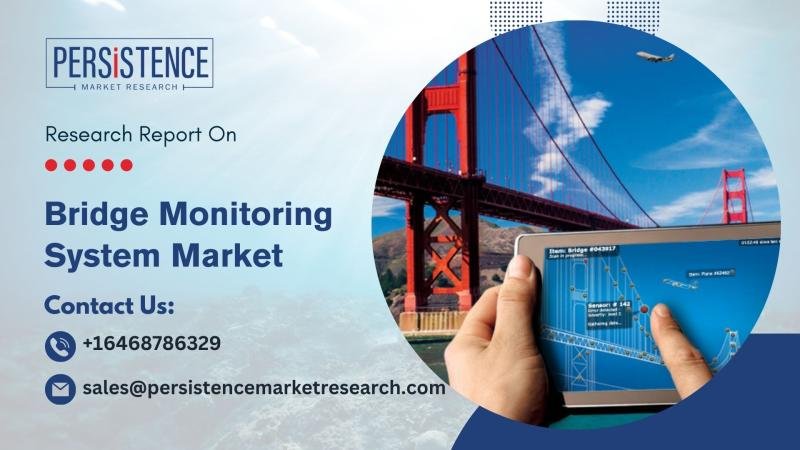As global infrastructure ages and climate-related risks rise, the need for advanced monitoring systems for bridges has grown exponentially. The bridge monitoring system market, valued at US$ 1,035.5 million in 2023, is projected to skyrocket to US$ 2,937.6 million by 2033, expanding at a CAGR of 12.1% during the forecast period. These systems are rapidly replacing traditional inspection methods by offering real-time, data-driven insights into the structural integrity of bridges.
This surge in demand is primarily driven by increased public safety concerns, the frequency of extreme weather events, and advancements in sensor and wireless technologies. North America currently dominates the market, accounting for 30% of global share in 2022, owing to aging infrastructure and robust technological investment. The hardware segment, especially monitoring sensors, leads the product landscape with a commanding 57.7% market share, reflecting the critical role physical components play in real-time structural health assessments.
Get a Sample PDF Brochure of the Report (Use Corporate Email ID for a Quick Response): https://www.persistencemarketresearch.com/samples/24487
➤ Key Highlights from the Report
➤ The bridge monitoring system market is forecasted to grow at a CAGR of 12.1% between 2023 and 2033.
➤ Hardware components, particularly sensors, held a 57.7% market share in 2022.
➤ North America leads the global market with a 30% share due to aging bridges and safety investments.
➤ Wireless monitoring systems dominated with a 66.7% market share in 2022.
➤ The U.S. alone held an 18.2% market share in 2022, emphasizing infrastructure revitalization.
➤ East Asia follows closely, with China contributing heavily to smart infrastructure upgrades.
Market Segmentation: Diverse Solutions for Different Needs
The bridge monitoring system market is segmented into hardware, software, and services. Among these, hardware components like vibration sensors, strain gauges, and corrosion detectors dominate the market due to their critical role in capturing real-time structural data. These components help detect cracks, stress, corrosion, and displacement well before any visual damage is apparent.
From a technological perspective, the market is bifurcated into wired and wireless systems. Wireless bridge monitoring systems have seen significant adoption due to lower installation costs, flexibility in deployment, and ease of maintenance. The wireless segment captured 60.6% of the market in 2022, highlighting its strong momentum in both new construction and retrofitting projects.
Regional Insights: A Global Push for Safer Infrastructure
In North America, aging infrastructure and regulatory mandates are pushing the adoption of bridge monitoring technologies. The U.S. accounts for over 60% of the regional market share, largely due to its 600,000 highway bridges, many of which are over 50 years old. Federal and state initiatives continue to invest heavily in structural health monitoring to prevent catastrophic failures.
Meanwhile, East Asia, led by China, is rapidly adopting these systems as part of smart city and sustainable infrastructure initiatives. With a market share of 40.8% in 2022, China is investing in real-time monitoring for major bridges like the Xupu and Zhanjiang Bay Bridges. India is also emerging as a high-growth market, forecasted to grow at a CAGR of 14.7%, thanks to increased government investment and wireless technology adoption.
Market Drivers
Rising Focus on Infrastructure Resilience
The need for real-time monitoring is no longer a luxury-it’s a necessity. As global infrastructure ages and natural disasters become more frequent, bridge monitoring systems offer critical insights into structural stress, fatigue, and potential failure points. This demand is further boosted by urbanization, traffic density, and climate change, pushing governments to invest in smart infrastructure solutions.
Market Restraints
High Installation and Maintenance Costs
Despite their advantages, bridge monitoring systems are not without challenges. High initial setup costs, especially for comprehensive sensor networks and real-time analytics platforms, can be prohibitive, particularly for developing economies. Additionally, maintenance and calibration services require skilled technicians, further increasing total ownership costs.
Market Opportunities
Integration with IoT and AI for Predictive Maintenance
The integration of AI, machine learning, and IoT technologies presents transformative opportunities. These smart systems allow for predictive maintenance, reducing long-term costs and improving safety. Furthermore, blockchain technology is being explored to ensure data transparency and integrity, offering a unique edge in stakeholder trust and compliance with regulatory mandates.
Frequently Asked Questions (FAQs)
➤ How Big is the Bridge Monitoring System Market?
The market was valued at US$ 1,035.5 Mn in 2023 and is expected to reach US$ 2,937.6 Mn by 2033.
➤ Who are the Key Players in the Global Market for Bridge Monitoring Systems?
Leading companies include Campbell Scientific, GEOKON, HBK, Monnit, and others.
➤ What is the Projected Growth Rate of the Market?
The market is expected to grow at a CAGR of 12.1% from 2023 to 2033.
➤ What is the Market Forecast for Bridge Monitoring System by 2032?
The market is projected to surpass US$ 2.9 Bn by the end of 2033.
➤ Which Region is Estimated to Dominate the Industry through the Forecast Period?
North America is projected to remain dominant due to aging infrastructure and regulatory pressure.
Company Insights
Leading companies are pioneering the development and deployment of bridge monitoring systems to ensure infrastructure safety and longevity.
✦ Campbell Scientific, Inc.
✦ GEOKON
✦ Monnit
✦ Dewesoft
✦ SENSR
✦ SMARTSENSYS
✦ Roctest Ltd
✦ MISTRAS Group, Inc.
✦ International Road Dynamics Inc.
✦ SignaGuard, LLC
Conclusion: A Smart Future for Infrastructure
The bridge monitoring system market is poised for dynamic growth over the next decade. As cities grow and infrastructure ages, the need for intelligent monitoring solutions becomes more pressing. Wireless connectivity, smart sensors, and AI integration are shaping a new era in public safety and infrastructure management.
Real-time bridge health monitoring is not only improving the reliability of transport networks but also helping authorities optimize maintenance budgets and prevent catastrophic failures. With technology advancing rapidly and public infrastructure under increasing stress, the market is entering a transformative phase, where predictive maintenance and smart infrastructure will become the new norm.
Contact Us:
Persistence Market Research
G04 Golden Mile House, Clayponds Lane
Brentford, London, TW8 0GU UK
USA Phone: +1 646-878-6329
UK Phone: +44 203-837-5656
Email: sales@persistencemarketresearch.com
Web: https://www.persistencemarketresearch.com
About Persistence Market Research:
At Persistence Market Research, we specialize in creating research studies that serve as strategic tools for driving business growth. Established as a proprietary firm in 2012, we have evolved into a registered company in England and Wales in 2023 under the name Persistence Research & Consultancy Services Ltd. With a solid foundation, we have completed over 3600 custom and syndicate market research projects, and delivered more than 2700 projects for other leading market research companies’ clients.
Our approach combines traditional market research methods with modern tools to offer comprehensive research solutions. With a decade of experience, we pride ourselves on deriving actionable insights from data to help businesses stay ahead of the competition. Our client base spans multinational corporations, leading consulting firms, investment funds, and government departments. A significant portion of our sales comes from repeat clients, a testament to the value and trust we’ve built over the years.
This release was published on openPR.
















